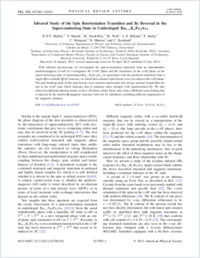Infrared study of the spin reorientation transition and its reversal in the superconducting state in underdoped ${\mathrm{Ba}}_{1-x}{\mathrm{K}}_{x}{\mathrm{Fe}}_{2}{\mathrm{As}}_{2}$
- Mallett, B. P. P. University of Fribourg, Department of Physics and Fribourg Center for Nanomaterials, Fribourg, Switzerland
- Marsik, Premysl University of Fribourg, Department of Physics and Fribourg Center for Nanomaterials, Fribourg, Switzerland
- Yazdi-Rizi, M. University of Fribourg, Department of Physics and Fribourg Center for Nanomaterials, Fribourg, Switzerland
- Wolf, Th. Institute of Solid State Physics, Karlsruhe Institute of Technology, Karlsruhe, Germany
- Böhmer, A. E. Institute of Solid State Physics, Karlsruhe Institute of Technology, Karlsruhe, Germany
- Hardy, F. Institute of Solid State Physics, Karlsruhe Institute of Technology, Karlsruhe, Germany
- Meingast, C. Institute of Solid State Physics, Karlsruhe Institute of Technology, Karlsruhe, Germany
- Munzar, Dominik Department of Condensed Matter Physics, Faculty of Science and Central European Institute of Technology, Masaryk University, Brno, Czech Republic
- Bernhard, Christian University of Fribourg, Department of Physics and Fribourg Center for Nanomaterials, Fribourg, Switzerland
-
08.07.2015
Published in:
- Physical Review Letters. - 2015, vol. 115, no. 2, p. 027003
English
With infrared spectroscopy we investigated the spin-reorientation transition from an orthorhombic antiferromagnetic (o-AF) to a tetragonal AF (t-AF) phase and the reentrance of the o-AF phase in the superconducting state of underdoped Ba1−xKxFe2As2. In agreement with the predicted transition from a single-Q to a double-Q AF structure, we found that a distinct spin density wave develops in the t-AF phase. The pair breaking peak of this spin density wave acquires much more low-energy spectral weight than the one in the o-AF state which indicates that it competes more strongly with superconductivity. We also observed additional phonon modes in the t-AF phase which likely arise from a Brillouin-zone folding that is induced by the double-Q magnetic structure with two Fe sublattices exhibiting different magnitudes of the magnetic moment.
- Faculty
- Faculté des sciences et de médecine
- Department
- Département de Physique
- Language
-
- English
- Classification
- Physics
- License
- License undefined
- Identifiers
-
- RERO DOC 257338
- DOI 10.1103/PhysRevLett.115.027003
- Persistent URL
- https://folia.unifr.ch/unifr/documents/304628
Other files
Statistics
Document views: 79
File downloads:
- ber_iss.pdf: 122
- ber_iss_sm.pdf: 77

